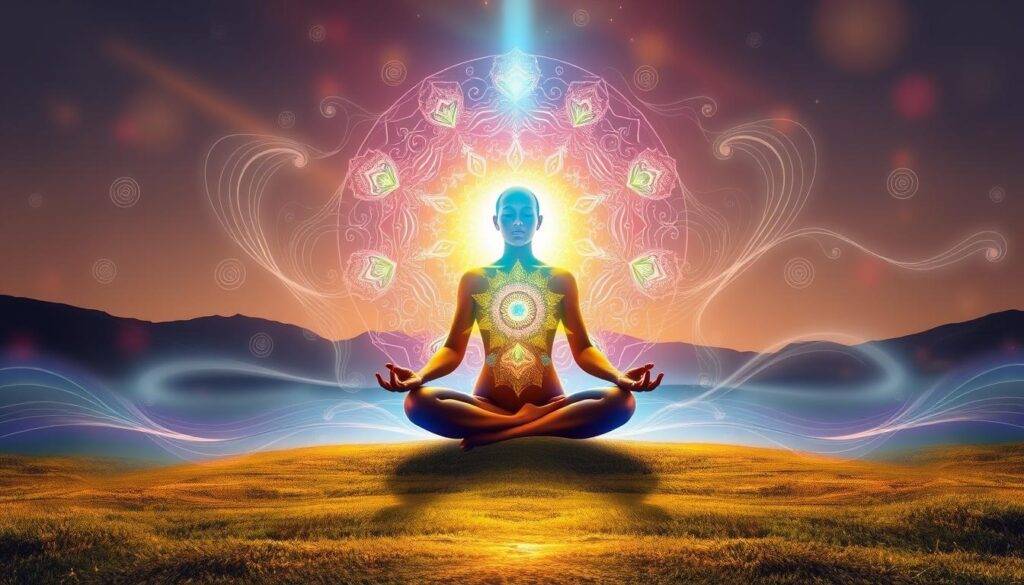“Not that which is perceived with the senses, but THAT which makes perception possible, know THIS to be the Eternal.” – Eckhart Tolle, summarizing the essence of the Kena Upanishad.
The ancient wisdom of yogic philosophy offers a deep understanding of the human experience. It uses the concept of the Five Koshas. These layers, from the physical to the blissful, help us explore and grow spiritually. As you start this journey, you’ll discover your true self and find a more harmonious life.
The Koshas, as described in the Taittiriya Upanishad, are like a map for your existence. They range from the physical body to the bliss sheath. Each layer shows a different part of your true self, the Atman. By understanding and integrating these Koshas, you can move beyond the ego and find self-realization.
Key Takeaways
- The Five Koshas provide a comprehensive framework for understanding the layers of human existence, from the physical to the spiritual.
- Exploring the Koshas can deepen self-awareness, foster spiritual growth, and help you navigate life’s challenges with greater clarity.
- Integrating practices tailored to each Kosha can lead to enhanced physical, mental, and emotional well-being.
- The journey through the Koshas mirrors the eight limbs of Raja Yoga, guiding you from the gross to the most subtle aspects of your being.
- The Koshas are interconnected, and working with them can help you realize your true nature, the Atman, the eternal and non-dual Self.
Understanding the Ancient Wisdom of Five Koshas Yogic Philosophy
The Five Koshas, or layers of self, come from ancient yogic teachings. They are rooted in the Vedantic philosophy, especially the Taittiriya Upanishad. This approach helps us grow and find our true selves.
Origins in Vedantic Teachings
The Five Koshas idea is a key part of Vedantic philosophy. It shows how our physical, mental, and spiritual parts are connected. The Upanishads say we have five bodies, each with finer energy.
The Significance of Koshas in Modern Practice
In today’s yoga, knowing the Koshas helps us balance our lives. They act as veils to our soul, guiding us to our true self or ‘atman’. This helps us find inner peace.
Connection to Yoga Sutras
The Five Koshas idea ties closely to Patanjali’s Yoga Sutras. It helps us understand and connect our physical, energetic, mental, and spiritual sides. This is in line with the Yoga Sutras’ teachings.
The yogic tradition teaches that individuals have five koshas, or bodies, each made of increasingly finer grades of energy. Only the first kosha is made of matter, while the other four consist of energy states that are invisible but can be experienced.
“Yoga emphasizes maintaining the health of the pranamaya kosha through exercises like diaphragmatic breathing and exposure to fresh air and sunlight.”
The Journey Through Layers of Consciousness
Yoga is a deep journey of self-discovery. It guides you through the Spiritual Anatomy and the Layers of Consciousness that make up your being. This journey aligns with the eight limbs of Raja Yoga. It invites you to explore your physical, energetic, mental, and spiritual dimensions.
Each Kosha represents a distinct level of consciousness. From the outermost physical layer to the innermost state of bliss. By understanding and working with these layers, you can deepen your yoga practice and personal growth.
- The Annamaya Kosha is the physical body sheath, encompassing your muscles, bones, and organs.
- The Pranamaya Kosha is the energetic layer, responsible for the flow of life force energy and breath.
- The Manomaya Kosha is the mental and emotional sheath, governing your thoughts, feelings, and reactive mind.
- The Vijnanamaya Kosha is the wisdom body, tapping into your intuition and witness consciousness.
- The Anandamaya Kosha is the bliss sheath, representing the state of unity, joy, and connection to the divine.
As you journey inward through these layers, you unveil the veils of maya, or illusion. You uncover your true essence – the egoless, luminous Self. This progression aligns with the eight limbs of Raja Yoga. It guides you from the outer, more tangible aspects of your being to the subtle, transcendent realms of your spiritual nature.
| Kosha | Level of Consciousness | Associated Yoga Limb |
|---|---|---|
| Annamaya Kosha | Physical Body | Asana |
| Pranamaya Kosha | Energetic Body | Pranayama |
| Manomaya Kosha | Mental and Emotional | Pratyahara, Dharana, Dhyana |
| Vijnanamaya Kosha | Wisdom Body | Dharana, Dhyana |
| Anandamaya Kosha | Bliss Body | Samadhi |
By exploring and integrating the Spiritual Anatomy of the five koshas, you embark on a transformative journey. You unveil the depth and vastness of your true nature. This holistic approach to yoga and self-discovery can lead you to profound states of awareness, self-mastery, and even enlightenment.
“The path of yoga is a journey of unraveling the veils of illusion, revealing the luminous essence of the Self.”
Annamaya Kosha: The Physical Body Sheath
The Pancha Maya Kosha, or the five layers of self in yogic philosophy, starts with the Annamaya Kosha. This is the physical body sheath. It’s made from the food we eat and the elements of the world around us.
Nourishing the Physical Layer
The Annamaya Kosha is linked to what we eat and how we live. Eating right, as taught by Ayurveda, is key to keeping this layer healthy. Eating natural foods and listening to our bodies helps the Annamaya Kosha stay strong.
Asana Practice for Physical Awareness
Yoga asana, or the physical postures, help us connect with the Annamaya Kosha. By doing different poses, we learn about our bodies and how they work. This awareness lets the prana, or life force, flow well, nourishing the Annamaya Kosha.
Connection to Food and Physical Health
The Annamaya Kosha is not just a body; it’s alive and changes with our choices. Eating right and staying active keeps it balanced. This supports our overall health and lets us explore deeper levels of consciousness.

“The physical body is the foundation upon which the entire yogic journey is built. By honoring and nourishing the Annamaya Kosha, we lay the groundwork for a profound and transformative self-discovery.”
Pranamaya Kosha: The Energy Body
The Pranamaya Kosha, or the vital energy sheath, is key in yogic philosophy. It’s made of prana, our life force. This layer connects our physical and mental worlds.
The Pranamaya Kosha isn’t something we’re born with. It’s built through practice. Pranayama (breathing exercises) and energy work like Reiki help balance it. Our breath, the source of prana, affects our thoughts and feelings.
“The yoga tradition identifies five progressively subtler bodies in human beings, made of specific types of energy. Specific exercises were developed by ancient yogis to strengthen and tone each of the five bodies.”
Understanding the Pranamaya Kosha connects our physical, mental, and spiritual sides. This approach to health brings vitality, emotional balance, and a deeper life connection.
Exploring the Vital Energy Sheath means tapping into your breath and ancient yoga wisdom. It opens the door to a more vibrant, balanced life.
Manomaya Kosha: The Mental and Emotional Sheath
In yogic philosophy, the Manomaya Kosha is our mental and emotional layer. It includes our thoughts, feelings, and how we see the world. Our upbringing, culture, and past shape this complex part of us.
Understanding Thought Patterns
The Manomaya Kosha handles our thoughts and emotions. By knowing our thoughts, we can understand why we act and react. This knowledge helps us find balance in this layer.
Emotional Intelligence and Mind Control
Our emotions greatly influence our life. Emotional intelligence helps us manage our feelings. Techniques like journaling and meditation can help us control our mind and emotions.
Meditation Techniques for Mental Balance
Yoga offers many meditation practices for the Manomaya Kosha. Japa and dhyana quiet the mind and help us feel calm. Regular practice leads to self-awareness and growth.
Vijnanamaya Kosha: The Wisdom Body
Explore Vijnanamaya Kosha, the layer of wisdom and discernment. It’s the highest part of your consciousness. It helps guide your moral and ethical choices through intuition and insight.
Vijnanamaya Kosha controls your higher thinking. It lets you see your thoughts and experiences clearly. By working on this layer, you understand yourself better. This helps you make better choices.
To improve Vijnanamaya Kosha, try these daily activities:
- Reflect on yourself and your thoughts often.
- Read spiritual texts to grow your knowledge and intuition.
- Use meditation to listen to your inner wisdom.
The journey to understand yourself is lifelong. By meditating on pure awareness, you connect more with Vijnanamaya Kosha. This connection brings you closer to the joy and bliss within you.

“The more you understand your true self, the more you can live in harmony with your deepest values and purpose.”
Anandamaya Kosha: The Bliss Sheath
Anandamaya Kosha is the innermost layer of the five koshas. It’s linked with pure joy, inner peace, and spiritual bliss. This sheath is the highest state of consciousness, closest to our true self or Atman. The goal of yogic practice is to reach this blissful awareness.
Experiencing Pure Joy
Yogic philosophy says Anandamaya Kosha is where we go beyond the physical, energetic, mental, and intellectual bodies. Here, we feel deep contentment, joy, and a connection to the divine. Advanced meditation, like Samadhi, helps us get to this blissful state.
Transcending Lower Koshas
To reach the Anandamaya Kosha, we must first develop the four koshas before it. This means growing self-awareness, emotional intelligence, and spiritual wisdom. By doing so, we can move past the lower sheaths and find the joy and bliss within.
“The ultimate purpose of the yogic path is to awaken the Anandamaya Kosha, the bliss sheath, and to experience the true nature of our being – pure consciousness and infinite joy.”
Unlocking the Anandamaya Kosha is our highest dharma, or life purpose. With consistent practice, dedication, and a strong commitment to self-discovery, we can find the endless bliss at our core.
Integrating the Koshas in Daily Practice
Embracing a holistic Integrating Koshas approach to your yoga practice is key. It unlocks profound self-discovery and well-being. This journey involves nurturing each of the five koshas – the physical, energetic, mental, intellectual, and blissful layers of your being.
To Holistic Yoga Practice, start with the physical sheath, the Annamaya Kosha, through mindful asana (posture) work. This grounds you in bodily awareness and optimal health. Pair your physical practice with Pranamaya Kosha breathwork, such as diaphragmatic breathing, to cultivate vital life force energy.
- Engage the Manomaya Kosha through meditation, journaling, and emotional self-inquiry to bring balance to the mind and emotions.
- Nourish the Vijnanamaya Kosha, your higher intellect and wisdom, through study of sacred texts, contemplation, and intuitive exploration.
- Ultimately, strive to access the Anandamaya Kosha, the blissful realm of pure joy and spiritual fulfillment, through deep meditation and practices that uplift your heart and soul.
A comprehensive yoga routine that integrates all five koshas leads to transformative personal growth. It brings a profound understanding of the self. Embrace this holistic approach to unlock your full potential and live with greater clarity, purpose, and inner peace.
| Kosha | Focus | Key Practices |
|---|---|---|
| Annamaya Kosha | Physical Body | Asana, Diet, Exercise |
| Pranamaya Kosha | Energy Body | Pranayama, Breath Awareness |
| Manomaya Kosha | Mental & Emotional | Meditation, Mindfulness |
| Vijnanamaya Kosha | Wisdom Body | Contemplation, Intuition |
| Anandamaya Kosha | Bliss Body | Deep Meditation, Gratitude |
“A balanced yoga practice that integrates all five koshas leads to comprehensive self-discovery and well-being.”
The Role of Pranayama and Meditation
Pranayama, the yogic art of breath control, and meditation are key in exploring our being. They target the five koshas, helping us go beyond the physical. We then reach the realms of energy, mind, wisdom, and bliss.
Breath Work Techniques
Pranayama, or breath work, is great for the Pranamaya Kosha, our energy body. Techniques like Nadi Shodhana, Kapalbhati, and Ujjayi improve prana flow. This affects our physical, mental, and emotional health.
Meditation Methods for Each Kosha
- Annamaya Kosha (Physical Body): Body scan meditation connects us with our physical body.
- Pranamaya Kosha (Energy Body): Breath awareness meditation tunes into our energy body.
- Manomaya Kosha (Mental Body): Mindfulness meditation brings clarity to our mind.
- Vijnanamaya Kosha (Wisdom Body): Self-inquiry meditation awakens our wisdom.
- Anandamaya Kosha (Bliss Body): Pure awareness meditation reveals our joy.
Using these meditation techniques, we can discover ourselves. We move from the physical to the subtle, finding wholeness and harmony.
Achieving Balance Through the Five Sheaths
Balancing the five koshas, or sheaths of being, is key to holistic well-being in yogic philosophy. Each layer – physical, energetic, mental, intellectual, and blissful – needs care to stay in balance. By knowing what each kosha needs, you start a journey of self-discovery and integration.
The outermost annamaya kosha needs good food and exercise. The pranamaya kosha, or energy body, grows with breathwork and sunlight. To nurture the mental and emotional manomaya kosha, focus on meditation and emotional smarts.
The vijnanamaya kosha, or wisdom body, blooms with ethical living and learning. The innermost anandamaya kosha – the bliss sheath – grows with self-care and joy.
By caring for each kosha, you find balance. This leads to better health, emotional stability, mental clarity, and growth. It’s the heart of yogic philosophy, helping you live a more complete and happy life.
“The five koshas represent the multidimensional nature of the self. Balancing these layers is the key to unlocking our full potential.” – Yoga Master, Swami Satyananda Saraswati
Conclusion
The Five Koshas Yogic Philosophy helps us understand our layers of existence and find self-realization. It guides us through the physical to the bliss body. This ancient wisdom makes yoga and lifestyle practices more meaningful, leading to true well-being and spiritual growth.
By balancing the five Koshas, you start a journey to wholeness and enlightenment. You nourish your physical, energetic, mental, intellectual, and blissful sides. This brings balance, resilience, and inner peace.
Exploring the Five Koshas can guide you through life’s complexities with grace and clarity. Let this ancient knowledge light your way to self-discovery. It helps you break free from limits and unlock your true potential.
FAQ
What are the Five Koshas in yogic philosophy?
The Five Koshas are layers of existence in yogic philosophy. They come from the Taittiriya Upanishad. These layers go from the physical body to the bliss sheath. They offer a complete view of human existence.
What is the significance of the Koshas in modern yoga practice?
The Koshas help us find balance in life’s physical, mental, and spiritual sides. They connect to Patanjali’s Yoga Sutras, especially the eight limbs of Raja Yoga. This method helps us discover our true self or ‘atman’.
How do the Koshas relate to the eight limbs of Raja Yoga?
The Koshas match the eight limbs of Raja Yoga: Yamas, Niyamas, Asana, Pranayama, Pratyahara, Dharana, Dhyana, and Samadhi. Each Kosha is a level of consciousness. Knowing them helps us grow in yoga and personal development.
What is the purpose of exploring the different Koshas?
Exploring and balancing the Koshas leads to well-being. It covers physical health, energy, mental clarity, wisdom, and bliss. This approach makes life more integrated and fulfilling.
How can pranayama and meditation help in working with the Koshas?
Pranayama and meditation are key in working with the Koshas. They use specific breath and meditation techniques. These target different Koshas, helping us move to more subtle levels of consciousness.
What are the practical benefits of integrating the Koshas into one’s lifestyle?
Integrating the Koshas means a holistic yoga practice. It includes physical, energetic, mental, intellectual, and spiritual practices. This balance improves physical health, emotional stability, mental clarity, and spiritual growth.




























































